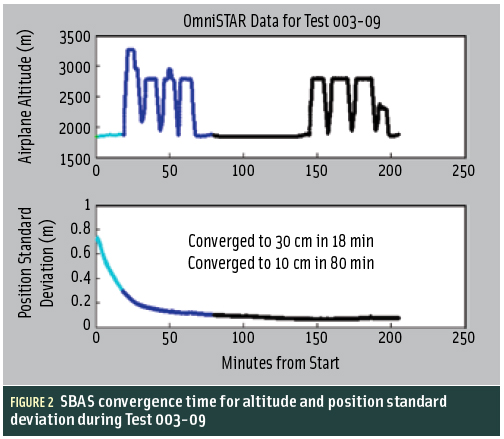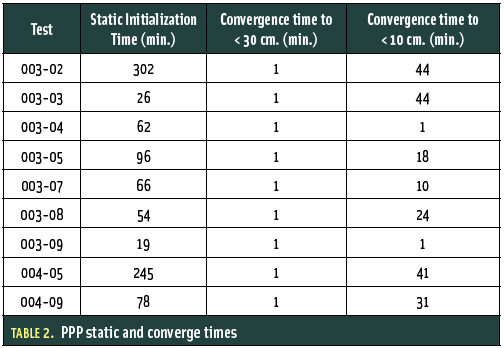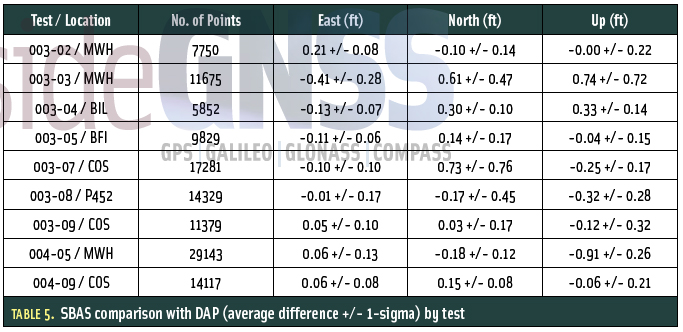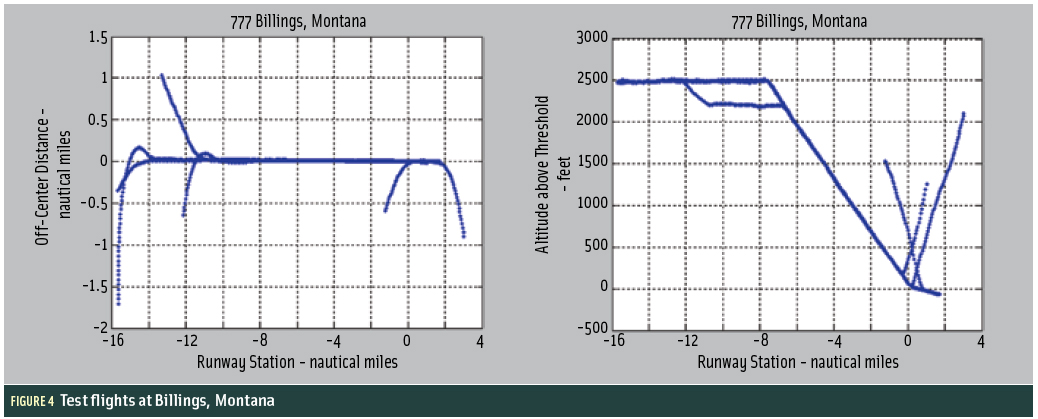During flight testing, Boeing technical personnel have historically used a differential GPS (DGPS) system as the position truth reference for validating various production systems on the airplane. The majority of those tests occur on or near remote runways to capture specific environmental conditions.
During flight testing, Boeing technical personnel have historically used a differential GPS (DGPS) system as the position truth reference for validating various production systems on the airplane. The majority of those tests occur on or near remote runways to capture specific environmental conditions.
Because DGPS systems require a ground reference receiver be placed in a known location, the ground system must be set up prior to flight testing. This requirement imposes many operational constraints on testing, including the loss of recorded data for the first landing and last take-off, the reduced flow time due to the ground set-up time, the cost of coordinating with the airports, increased costs for extra personnel to operate the ground station, and the purchase and maintenance of a second GPS receiver.
In an effort to reduce test flow-time, operational costs, and provide an accurate and efficient truth reference system for airplane position solutions, we investigated two technologies. One method incorporated a real-time GPS system using commercial satellite-based augmentation system (SBAS) corrections, and the other was a post-processing method that employed a precise point positioning (PPP) solution.
For more than 33 flight hours during nine test flights, we examined position data both in terms of latitude, longitude, and altitude, as well as using runway coordinates. In order to capture specific environmental conditions, the test flights were conducted over selected regions in the western United States and at high latitudes.
In this article, we present results of our research in terms of methods, test flight regions, and maneuvers, including takeoffs, landings, touch-and-go’s, turns, ascents, descents, and high altitude maneuvers.
Our Current Test Bed
Boeing’s baseline position reference system, DGPS Aircraft Position (DAP) System, uses data collected from a dual-frequency GPS reference receiver to estimate ranging errors. These ranging errors from the reference receiver are applied to data gathered by the airplane’s receiver to improve the accuracy of its position data.
This DAP System collapses satellite position and clock errors and the common parts of ionospheric and tropospheric group delay errors into ranging errors that are common to the reference and airplane receivers. Post-processing removes these common errors as well as receiver clock errors, and the dual frequency signals are used to address residual ionospheric group delay.
However, this method does not address ground receiver measurement error that can be introduced by use of a reference receiver. Thus, the positions generated by the airplane receiver, however precise, are biased by any error in positioning the reference receiver.
Option 1: SBAS
A satellite-based augmentation service provides accurate, real-time positioning corrections for GPS data via an airplane’s GPS+L-band antenna.
A control station accumulates information about the GPS satellites’ orbits and satellite-receiver clock offsets collected by a network of independent reference stations equipped with dual-frequency receivers. The control station calculates corrections to the satellite data and transmits these in real-time via a geostationary (GEO) satellite. Software in the receiver on board the test airplane applies these corrections to the aircraft’s position solution, adds the ionospheric corrections derived from the L1/L2 signals, and applies tropospheric corrections from a generic model.
The GEO provides precise satellite orbit information every minute and precise clock information, every 10 seconds. When the positions of the satellites are known within 20-30 meters and the satellite clock error is known within a nanosecond (effectively, 30 centimeter of ranging error), the system can estimate positions with accuracies up to the decimeter level without the use of reference stations. This technique can also be called real-time precise point positioning.
One drawback associated with the use of the commercial SBAS system is its need for a static initialization time to get the best results. This means that if the GPS satellite signal is lost, a receiver may require up to five minutes for the SBAS-corrected position solution to reinitialize and converge to acceptable accuracy levels comparable to our current DAP system. This initialization time increases if the airplane is in motion.
Table 1 shows the static initialization period and convergence time for each of our studied flights. In order to meet DAP system requirements, we found we must operate the receiver statically for about 25 minutes.
Note that in two tests (indicated by * in Table 1) the airplane took-off from a static position nearly at the same time as the SBAS solution converged to a reported position error of less than 30 centimeters. In both cases, the solution eventually did converge as the airplane was in motion.
Figure 1 shows the airplane altitude and position standard deviation for Test 003-03 presented in Table 1. In this case, the SBAS system realized the 30-centimeter error almost immediately, but never reported errors below 10 centimeters. Other effects, such as satellite geometry may have contributed to this behavior.
Test 003-09 results are shown in Figure 2. The SBAS position solution did converge to the 10-centimeter level, but it took 80 minutes due in part to the high dynamics of the airplane during the convergence period.
The SBAS signal from the GEO can be lost for up to two minutes without requiring reinitialization of the SBAS-corrected solution. During the test flights reported here, we did not encounter any GEO signal dropouts. In all tests in this study, the SBAS positions converged to acceptable levels for the Flight Test DAP system.
Option 2: PPP
Precise point positioning is a post-test method that uses a worldwide network of GPS receivers similar to that of the commercial SBAS network in order to generate precise GPS satellite orbit and clock corrections in addition to corrections for earth tides, ocean loading and polar motion. Our current PPP software can be used to mitigate errors, apply the corrections, and remove estimated receiver clock error to generate highly accurate positions.
PPP accuracy also depends on GPS satellite geometry. Flight test logistics must optimize the availability of GPS space vehicle (SV) signals and good geometry and also include static time periods for quicker convergence. This is especially true for tests with high airborne dynamics.
We use a mission-planning tool to determine if the geometry and availability is sufficient, but we do not drive our schedule to those results. Our system is used as a truth reference for the positioning capability of real-world aviation products, but it is not a safety-of-life system in itself; so, integrity issues do not enter into the tests.
Table 2 shows the PPP convergence times and is comparable to those in Table 1 for SBAS methods.
Since the PPP algorithm essentially resets with each significant loss of lock, this convergence time should be considered relevant to each initialization time in the data set. We did not encounter any loss of lock during these particular test scenarios. In fact, in practice for the type of testing for which we use this system, we do not encounter loss of lock. The data sets in this study show that the PPP positions converged quickly to acceptable levels for the Flight Test DAP system.
The PPP solution uses corrections from Center for Orbit Determination in Europe (CODE). Post-processing provides an advantage over real-time SBAS solutions, in that the position solution is less dependent on the initial static time period, due to the ability to process data both forward and backward, combining two independent solutions. The PPP software generates a forward solution, a reverse solution, and a combined solution. We used the combined solution.
The solution quality improves with increased static periods anywhere in the data set. This can be considered a drawback to using PPP, but it is easy to accommodate by leaving the receiver on after the airplane has landed for an additional period of time to assure a long enough data set has been recorded. Experience has shown that the recording session should be at least two hours in length to provide quality data with accuracies in the range of 10 to 20 centimeters.
The primary drawback associated with the postprocessing-based PPP technology is that the corrected position data is not immediately available. PPP support data required for DAP processing are either rapid files or final files, available through the International GNSS Service (IGS).
Rapid files contain orbit correction data at 15-minute intervals, and satellite clock corrections at 5-minute intervals. The updated files are produced daily and are available 17 hours after each end of Coordinated Universal Time (UTC) day, which is about 4 p.m. the following day at our research offices in Seattle. IGS rapid files are available from several participating agencies where each agency has an independent set of monitoring stations.
The IGS final files are updated weekly with a 12-day latency. Each week participating IGS agencies submit their Rapid files to the IGS analysis centers, which process them together to create the final files. These files are the most precise files available but are comparable to the rapid files in accuracy for the purposes of our application.
Practical Matters
One of the important assumptions made when operating a differential system such as our DAP system is that the reference receiver is placed in a precisely surveyed “known” location, typically marked on the ground and photographed by the original surveyor. Once a suitable site for a DAP reference station is located near the airport from which the test aircraft takes off, the person setting up the tripod and receiver antenna must precisely place the equipment over the reference monument.
When tests are run over multiple days, changing environmental conditions may cause some variation in the placement of the receiver antenna. For DGPS applications, these variations are inconsequential to the position solution because the previously surveyed runway and the reference site remain a constant distance apart in our data-processing calculations.
Another practical consideration is ensuring that, geodetically speaking, we are comparing apples with apples and not apples with oranges. For example, in one test in Keflavik, Iceland, we compared our DAP and PPP techniques using initial position data collected from a test Boeing 767 while the airplane was stationary near the center of the runway. We encountered very large differences between the DAP and PPP results: 16 feet in runway station, 70 feet in off-center distance, and 75 feet in altitude.
We found the largest biases when the reference site survey data was post-reprocessed using the PPP method. Due to the accuracy of this method, we discovered that the bias was due to differences between the map datum in which the reference station was positioned and the GPS reference frame, WGS84. We successfully removed the bias by converting all survey and airplane data to the same realization of WGS84 — G1150.
Having resolved the initial bias due to datum differences, test-to-test comparisons showed further biases between the systems ranging from 0.5 to 1.5 feet. Discussions with personnel attending the tests revealed that the DAP reference site had been obscured, so that variations in siting the antenna at the reference location occurred from day to day. Again, the PPP post-processing method was used to identify and remove the biases, and the actual locations were accurately and precisely identified and used each day.
As a result of this discovery, we re-worked much of our survey database to bring precise values into the equation for both the reference sites and the runways. Due to this increased accuracy and precision from these discoveries, we were able to eliminate survey errors and compare the computed position differences amongst the three methods more precisely.
Data Analysis
The tests on which the analyses in this article are based were performed flying a Boeing 777 Freighter on nine different days near four different airport facilities with reference sites operated by Boeing Flight Test located nearby: Boeing Field (BFI) in Seattle, Washington; Moses Lake, Washington (MWH); Colorado Springs, Colorado (COS); and Billings, Montana (BIL).
Figure 3 shows the 777’s flight path for these tests, which generated 121,355 points of common data for takeoffs, landings, touch-and-go’s, turns, ascents, descents and high altitude maneuvers. Data were collected by both reference site and on on-board receivers one sample per second.
The number of comparisons was only limited by the availability of differential data. For each flight, the airborne GPS receiver remained on throughout the duration of the conditions flown. For all flights except one, the reference sites were located near the airport and runway facility, and operated by our flight test group. The one test day where no reference site was available occurred at Moses Lake; here, differential data was calculated using data from an IGS reference site, P452.
We present the data from two perspectives: A comparison of longitude (East), latitude (North), and height (Up) during the entire test day, and a comparison of on condition data in runway coordinates. The total of 121,355 common data points at one sample per second is equivalent to about 33.7 hours of data.
SBAS Comparison with DAP DGPS
Table 3 presents the differences in airplane position results between differential DAP and real-time SBAS corrected solutions, disaggregated into East, North and Up components. These components are obtained providing the least amount of data manipulation to produce good system-to-system comparisons.
The results show that SBAS corrected positions compare very well with our DAP differential positions. Table 4 groups these results by reference site location and Table 5 breaks the statistics down by test number.
PPP Comparison with DAP Differential
Table 6 presents the differences in airplane position results between differential DAP and PPP solutions in East, North, and Up components.
Results show that the PPP solution agrees very well in all three dimensions with the DAP solution. Table 7 groups the results by location, and Table 8 breaks the statistics down by test number.
On-Condition SBAS Comparison with DAP
For autoland tests the airplane is typically “on-condition” 10 to 15 miles from the runway until the approach is terminated with a missed approach, touch and go or full stop. These data sets also include occasional take-off conditions.
The on condition data presented here are a subset of the comparison data presented earlier. For example, Figure 4 presents plan and side views of all on condition processed data during test 003-04 at Billings, Montana, where there were four approaches and one take-off.
The on-condition comparisons are presented in runway coordinates: runway station, off-center distance, and altitude above threshold. Therefore, these results include errors associated with the transformation from earth-centered, earth-fixed coordinates as well as DAP and SBAS errors. Table 9 presents the comparisons from eight tests at four facilities.
The accuracy criteria for an autoland reference system were previously established as 1.5 feet (2-sigma) for each dimension. The data in Table 9 indicates that SBAS meets these criteria.
The data from test 003-03 at Moses Lake provides further insight into how the system works. Because the GPS receiver was not turned on soon enough for warm up, accuracies were not as good as during the other tests. Fortunately, the SBAS software recognized this and self-reported the degradation in solution quality.
After translating the data to an IGS reference site about 25 kilometers from the runway, test 003-03 reported accuracies are consistent with independent source. This exercise also verified that survey adjustments made at MWH using PPP were implemented correctly.
On-Condition PPP versus DAP
Further on condition comparisons of PPP and DAP data were made during testing of a Boeing 777. DAP data was collected in conjunction with the SBAS data reported above. The 767 data were collected in Keflavik, Iceland and was included in the study to show that this technology works at high latitudes.
Table 10 is the complement of Table 9 and includes the same DAP data compared with PPP results. This table shows, with little doubt, that PPP and DAP results are indeed equivalent.
Table 11 presents the data from the first aircraft test, collected in Keflavik, Iceland, after converting all survey and airplane data to the same WGS84 datum (G1150), and correcting for antenna siting variations. We include this data here to show that PPP processing is valid at high latitudes.
Conclusion
Our research presented here shows that we can replace a legacy DGPS system for airborne applications with newer techniques that do not require a second, ground-based reference receiver. Data shows the SBAS-based position solution to be sufficiently accurate, reliable, and more efficient than traditional DGPS solutions. Post-processed PPP methods also produce accuracies as good as current DGPS systems for airborne data.
Data from both these systems agreed to within 16 inches East, 6 inches North, and 19 inches Up with 95 percent confidence. Table 12 compares the DAP, SBAS, and PPP accuracies in the ENU components.
Operationally, the real-time SBAS data provides the most efficient solution and avoids the latency issues associated with the PPP processing. That being said, the use of PPP data as a back-up to the SBAS data provides quality assurance due to PPP’s independent forward and reverse solutions, which can serve as an overall system “sanity check.”
Operations using these methods at higher latitudes raise no additional concerns or require any additional accommodation, except for some mission planning to avoid periods of weak satellite geometry and real-time monitoring to accommodate initialization periods for both PPP and the SBAS techniques.
Both the SBAS and PPP technologies provide a replacement to our DGPS system and allow us to dispense with the need for a second, ground-based receiver. Both alternatives improve the efficiency of our test work flow without compromising accuracy or integrity of the data. In fact, we expect that as the technology improves, so will our system.
Our next will be a high latitude test of the SBAS-based system, including a polar flight. This should give us a good look at the GPS receiver’s capabilities to automatically transfer from one GEO beam to another in flight and to see at what latitudes we might encounter difficulty receiving the SBAS signal. We also hope to validate that the PPP solution is truly worldwide as far north as the pole.
Acknowledgements
The authors of this paper would like to thank Michael Brown, President and owner of Steve Lieber & Associates Inc., for his invaluable assistance in understanding our equipment capabilities and for his patience while answering innumerable questions.
Additional Resources
[1] Bisnath, S. B., and T. Gao, “Innovation: Precise Point Positioning,” GPS World, Vol. 20 No. 4, p. 43, 2009
[2] Misra, P., and P. Enge, Global Positioning System: Signals, Measurements and Performance, 1st. Ganga-Jamuna Press, Lincoln, Massachusetts USA, 2001
[3] OmniSTAR on the Internet, OmniSTAR, Inc., 2005, located at: www.omnistar.com/how_tech.html
[4] Waypoint Products Group, NovAtel Inc., Airborne Precise Point Positioning (PPP) in GrafNav 7.80 with Comparisons to Canadian Spatial Reference System (CSRS) Solutions, 2006
[5] Zhang, X., Precise Point Positioning, Evaluation and Airborne Lidar Calibration, Danish National Space Center, Technical Report No. 4, 2005





